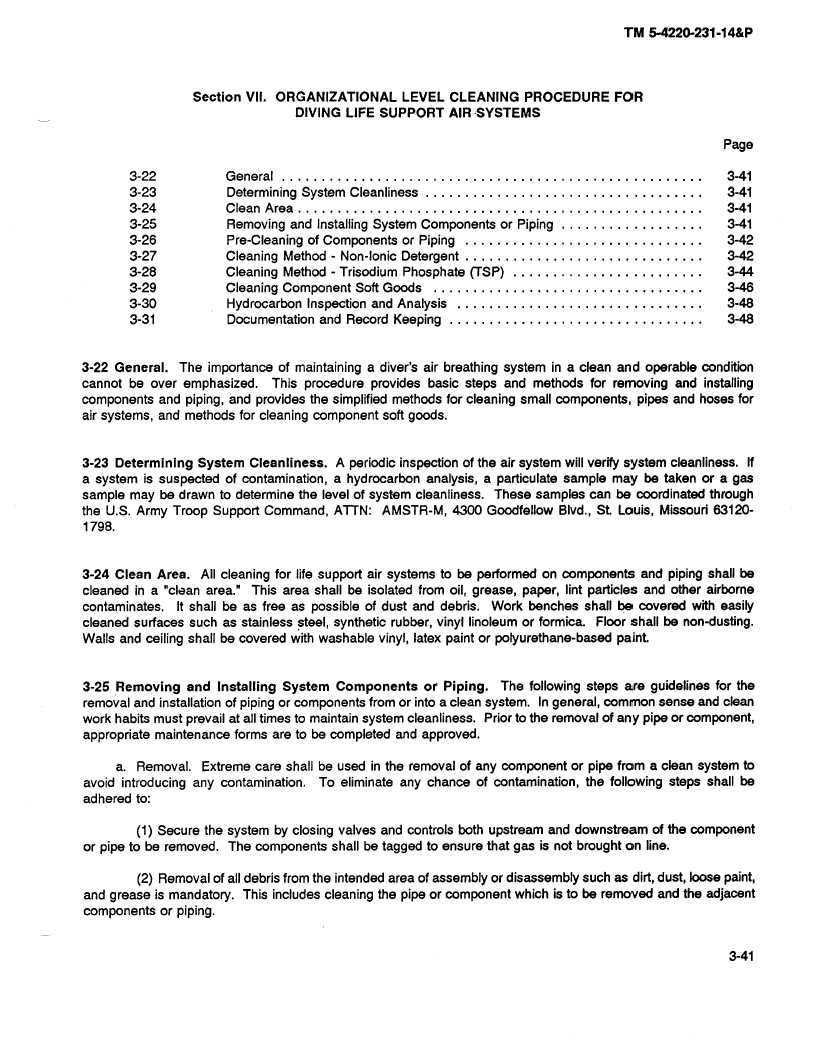TM 5-4220-231-14&P
Section VIl. ORGANIZATIONALLEVELCLEANING PROCEDURE FOR
DIVING LIFE SUPPORT AIRSYSTEMS
Page
3-22
General
.....................................................
3-41
3-23
Determining
System
Cleanliness
...................................
3-41
3-24
Clean
Area
...................................................
3-41
3-25
Removing
and Installing
System
Components
or Piping
..................
3-41
3-26
Pre-Cleaning
of Components
or Piping
..............................
3-42
3-27
Cleaning
Method - Non-Ionic Detergent
..............................
3-42
3-28
Cleaning
Method - Trisodium
Phosphate
(TSP)
........................
3-44
3-29
Cleaning
Component
Soft Goods
..................................
3-46
3-30
Hydrocarbon
Inspection
and Analysis
...............................
3-48
3-31
Documentation
and Record
Keeping
................................
3-48
3-22 General.
The importance
of maintaining
a diver's air breathing
system
in a clean and operable
condition
cannot
be over emphasized.
This procedure
provides
basic steps
and methods
for removing
and installing
components
and piping, and provides
the simplified methods
for cleaning
small components,
pipes and hoses for
air systems,
and methods
for cleaning
component
soft goods.
3-23 Determining
System
Cleanliness.
A periodic inspection
of the air system will verify system
cleanliness.
If
a system
is suspected
of contamination,
a hydrocarbon
analysis,
a particulate
sample
may be taken or a gas
sample
may be drawn
to determine
the level of system
cleanliness.
These
samples
can be coordinated
through
the U.S. Army Troop
Support
Command,
ATTN:
AMSTR-M,
4300 Goodfellow
Blvd., St. Louis,
Missouri
63120-
1798.
3-24 Clean
Area.
All cleaning
for life support
air systems
to be performed
on components
and piping shall be
cleaned
in a "clean
area."
This area
shall be isolated
from oil, grease,
paper,
lint particles
and other airborne
contaminates.
It shall be as free as possible
of dust
and debris.
Work benches
shall be covered
with easily
cleaned
surfaces
such
as stainless
steel,
synthetic
rubber,
vinyl linoleum
or formica.
Floor shall be non-dusting.
Walls
and ceiling shall be covered
with washable
vinyl, latex paint or polyurethane-based
paint.
3-25
Removing
and
Installing
System
Components
or Piping.
The
following
steps
are
guidelines
for the
removal
and
installation
of piping
or components
from or into a clean
system.
In general,
common
sense
and clean
work habits
must
prevail
at all times
to maintain
system
cleanliness.
Prior to the removal
of any pipe or component,
appropriate
maintenance
forms
are
to be completed
and
approved.
a.
Removal.
Extreme
care
shall
be used
in the
removal
of any component
or pipe from
a clean
system
to
avoid
introducing
any
contamination.
To
eliminate
any
chance
of contamination,
the
following
steps
shall
be
adhered
to:
(1) Secure
the system
by closing
valves
and
controls
both
upstream
and
downstream
of the
component
or pipe to be removed.
The
components
shall
be tagged
to ensure
that gas
is not brought
on line.
(2) Removal
of all debris
from the intended
area
of assembly
or disassembly
such
as dirt, dust,
loose
paint,
and
grease
is mandatory.
This includes
cleaning
the
pipe or component
which
is to be removed
and the
adjacent
components
or piping.
3-41

